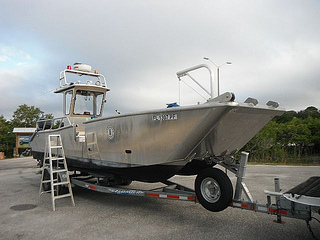
Boaters should consider additional fuel prep when a boat will not be in use for an extended time period. Photo Courtesy of Florida Sea Grant
Since the introduction of 10% ethanol to gasoline (E-10 fuel) many boaters, including yours truly, have had problems with fouled fuel filters and marine engines not running at their top performance. The ethanol added to the fuel combines with oxygen increasing the combustion process. This makes for a more efficient burning fuel and less emissions for the environment. Sounds great, but it has been a nightmare for mariners.
The problem with boats is that we do not use them on a daily basis as we do our cars. When E-10 fuel sits it will absorb oxygen via water vapor through the vents. Over time the ethanol/water mixture begins to separate from the gasoline in a process called “phase separation”.
Extreme separation leaves a milky, rusty brown mixture at the bottom of the fuel tank; right where the intake for the fuel line is on many motors. This mixture moves through the motor clogging fuel filters, miss-firing, or not running at all.
Water contaminated ethanol fuel creates a mixture that can breakdown fiberglass fuel tanks, fuel lines, and sealing rings releasing particles that plug filters as well. To counter this problem Jeff Posner, of Posner Marine in Pensacola, recommends a fuel stabilizer that will inhibit phase separation. The manufacturers state that adding the correct amount will inhibit separation for 12 months. A colleague of mine has used this product while his boat sat for three months and had no problems with the engine after that period of time. Posner does recommend you read the label to make sure you are purchasing “marine-grade” stabilizer and not one meant for lawn mowers or chains saws. CR 4000 fuel lines will inhibit deterioration but Posner mentioned that motors built since 2000 should have these already.
WHAT SHOULD I DO WITH THE E-10 FUEL OVER LONG PERIODS OF NON-USE?
Many boaters park their boats for the winter. There has been a debate as to whether to store the can empty and buy new fuel in spring or store full with stabilizer. According to several sources the better of the two options is to fill the tank 95% full and add the stabilizer. Empty space in the tank will fill with water vapor entering through the vents. More space equals more water which equals more separation which equals more problems. The tank should be 95% full to allow for expansion of gases. Many portable fuel tanks do not have vents, thus no water vapor entry, but Posner states any water vapor in the tank will trigger separation if the temperature increases; so keep portable tanks cool and out of the sunlight. He also recommends that the fuel with stabilizer run through the motor before you park it for the winter.
There are service stations in the Panhandle that sell gasoline with no ethanol; this can also be found at many local marinas. The cost may be more but could save you frustration and money down the road. The government is now considering E-15 fuel. Posner stated that the newer marine engines are designed for the E-10 but not the E-15, and that you should not use that in your boat until newer marine products designed for it are on the market.
So… when storing fuel in your motor over the winter, fill the tank, add stabilizer, run fuel through the motor, and place a new filter/water separator on the line for spring. With good winter prepping you should have a great boating summer. You can find more information at the following:
http://www.boatus.com/seaworthy/ethanol.asp
http://msucares.com/newsletters/gulf/201203.html
http://hawaii.gov/dlnr/dbor/e10gas.htm
http://www.oregon.gov/osmb/pages/news/e10winterizing.aspx
- Rattlesnakes on Our Barrier Islands; Part 1 Knowing the Snake - December 8, 2025
- Tips for Bear Encounters this Fall - November 10, 2025
- Pensacola Bay Invasive Species Summer Survey 2025 - November 3, 2025
